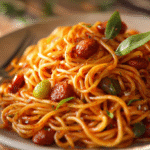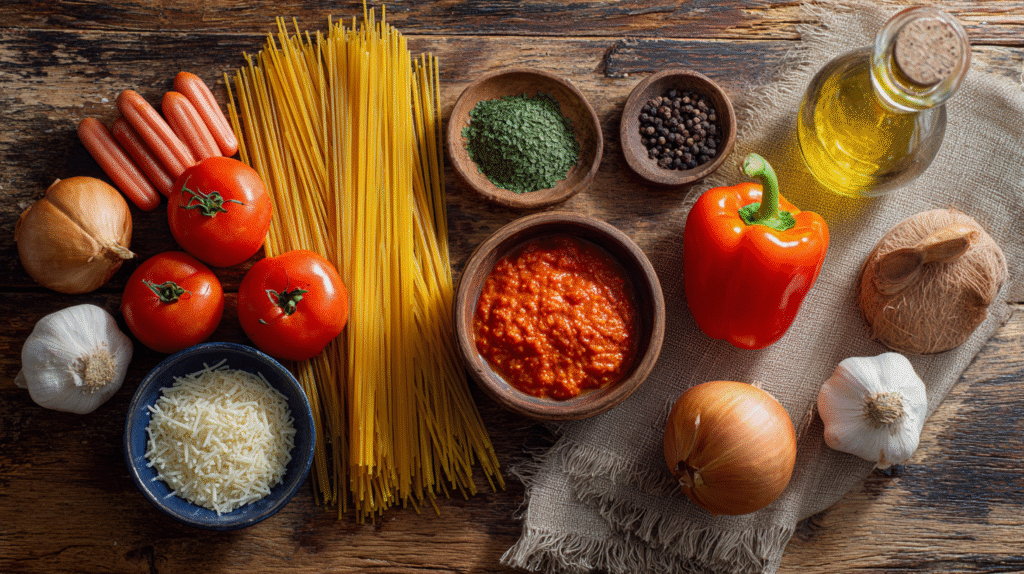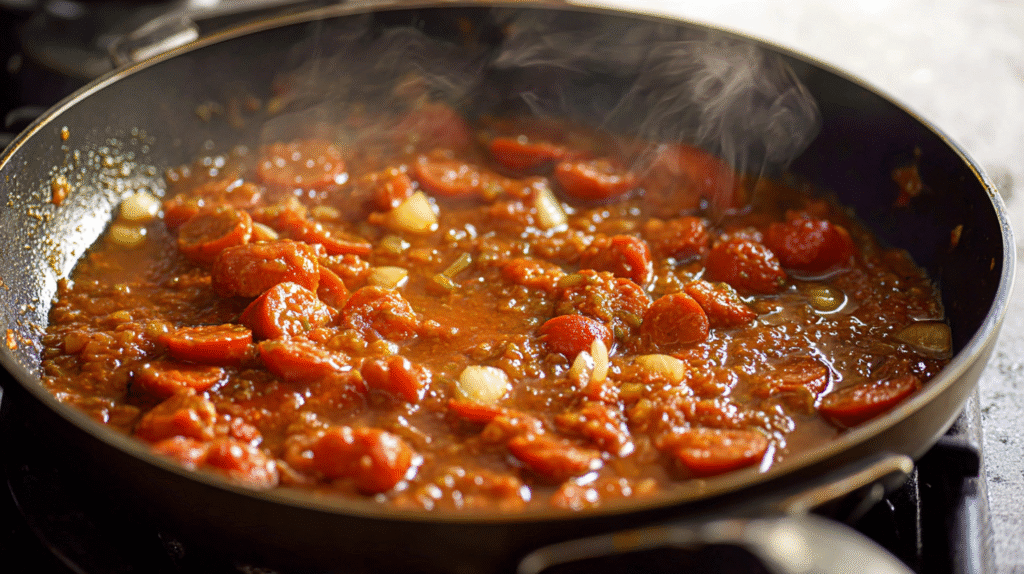When it comes to soul-satisfying, flavor-loaded meals, few dishes rival a well-made Haitian spaghetti recipe. This savory breakfast staple, known as Espageti, carries a special place in the hearts of Haitians worldwide. Whether eaten on a weekday morning or served during weekend brunch, it combines the boldness of epis with the comfort of familiar ingredients like hot dogs or smoked sausage. In this article, you’ll learn how to make it perfectly, explore its cultural roots, and discover the best ways to enjoy it. From family-style comfort to next-level Caribbean flavor, Haitian spaghetti delivers every time.


Haitian Spaghetti Recipe: The Authentic Espageti Haitien You’ll Crave
- Total Time: 30 minutes
- Yield: 4 servings 1x
- Diet: Halal
Description
Savory, spicy, and comforting—this Haitian spaghetti recipe combines hot dogs or sausage with a bold epis-tomato base. Perfect for breakfast, lunch, or dinner.
Ingredients
1 package (16 oz) spaghetti
4–6 hot dogs or smoked sausage
2 tbsp tomato paste
3 tbsp Haitian epis
1 bouillon cube (Maggi)
1 onion, sliced
½ green bell pepper, sliced
½ red bell pepper, sliced
1 scotch bonnet pepper (optional)
½ tsp garlic powder
½ tsp Adobo seasoning
¼ cup olive oil
2 tbsp vegetable oil
Salt, to taste
Reserved pasta water (½ cup)
Instructions
1. Slice hot dogs or sausage and boil for 5 minutes until plump. Drain and set aside.
2. Cook spaghetti in salted water until al dente, adding 1 tbsp oil. Reserve ½ cup pasta water and dissolve bouillon cube in it.
3. In the same pot, heat olive oil. Stir in tomato paste and cook for 2–3 minutes.
4. Add epis and boiled sausage. Sauté for 2 minutes until fragrant.
5. Stir in sliced onion, bell peppers, scotch bonnet (if using), garlic powder, and Adobo. Cook 3 minutes.
6. Pour in reserved bouillon water and simmer until sauce thickens slightly.
7. Add spaghetti back to pot. Toss well to combine with sauce and protein. Let rest a few minutes before serving.
Notes
Serve with sliced avocado, boiled egg, or spicy pikliz on the side.
For vegan variation, use plant-based sausage and increase vegetables.
Smoked herring (aransol) is a traditional alternative to sausage—rinse and sauté before adding.
Leftovers can be stored for up to 3 days in the fridge or frozen for future meals.
- Prep Time: 10 minutes
- Cook Time: 20 minutes
- Category: Breakfast
- Method: Stovetop
- Cuisine: Haitian
Nutrition
- Serving Size: 1 plate
- Calories: 540
- Sugar: 4g
- Sodium: 980mg
- Fat: 24g
- Saturated Fat: 7g
- Unsaturated Fat: 14g
- Trans Fat: 0g
- Carbohydrates: 60g
- Fiber: 3g
- Protein: 18g
- Cholesterol: 45mg
Keywords: Haitian spaghetti recipe, Haitian espageti, spaghetti with hot dogs Haitian style, Haitian comfort food
Why Haitians Love Spaghetti for Breakfast
From Childhood Memories to Comfort Food
Growing up in a Haitian household, mornings often started with the aroma of epis sizzling in a pan. The Haitian spaghetti recipe wasn’t just another meal—it was a warm hug on a plate. The combination of tomato paste, garlic, and onions wrapped around pasta was the flavor of home. Many families, including mine, had their own twist on this iconic dish. Some preferred it spicy, others mild. But no matter how it was made, it always brought people together around the table.
For those who grew up in Haiti, spaghetti with hot dogs Haitian style evokes nostalgic feelings. It wasn’t just convenient and affordable—it was delicious. Leftovers became lunch, sometimes even dinner. The dish’s affordability and simplicity made it accessible, but the taste is what made it unforgettable.
This recipe has seen generations pass it down and remix it. Today, many people are discovering the beauty of Haitian comfort food, and this recipe is a delicious entry point.
Espageti Haitien: A Dish of Identity
Ask any Haitian, and they’ll tell you: this isn’t your average pasta. It’s not meant to be drowned in sauce. In fact, the traditional Haitian pasta dish is intentionally light on sauce. The bold flavor comes from the base—epis, Haiti’s beloved seasoning mix of bell peppers, onions, garlic, and herbs.
In Haitian homes, spaghetti haitienne is more than food—it’s tradition. The recipe varies slightly by region and even by household, but the essence remains the same: a one-pot dish, packed with flavor and always satisfying. What sets it apart from other Caribbean spaghetti recipes is the unique mix of spice, savoriness, and creativity. In some families, smoked herring (aransol) takes center stage; in others, it’s spicy kielbasa or butter-slicked spaghetti with pikliz on the side.
And while spaghetti might be a dinner food elsewhere, in Haiti, it’s often enjoyed for breakfast—paired with sliced avocado, a boiled egg, or a piece of buttered bread. Just like this breakfast favorite, it’s hearty and energizing, perfect to start your day with purpose.
As more food lovers around the world seek out authentic, comforting meals, Haitian-style noodles are having their moment—and for good reason. They’re simple, customizable, and packed with vibrant flavor from start to finish.
Making the Best Haitian Spaghetti
Essential Ingredients for Real Espageti

The beauty of a true Haitian spaghetti recipe lies in its simplicity. Each ingredient is carefully chosen to bring maximum flavor. Here’s what you need to get started:
| Ingredient | Purpose |
|---|---|
| Spaghetti (16 oz) | Base of the dish; traditionally long noodles |
| Hot dogs or smoked sausage | Classic protein in Haitian spaghetti with sausage flavor |
| Epis (Haitian seasoning base) | Core flavor; includes garlic, onion, bell pepper, thyme |
| Tomato paste (2 tbsp) | Richness and depth |
| Bouillon cube (Maggi or alternative) | Umami boost |
| Bell peppers (½ red, ½ green) | Sweet, earthy crunch |
| Onion (1 medium, sliced) | Savory base |
| Scotch bonnet pepper (optional) | Adds traditional heat |
| Olive oil + Vegetable oil | Flavor and sauté base |
Looking for a deeper flavor? Add a spoonful of homemade epis or try incorporating pikliz for tang and spice. Many Haitians swear by that little extra heat to bring the dish to life.
How to Make Haitian Spaghetti (Step-by-Step)
Here’s how to prepare this savory Haitian comfort food from scratch. The method is straightforward, but the order and timing matter.

- Boil the hot dogs or sausage. Slice your protein into bite-sized pieces and boil them in water until plump, about 5 minutes. Drain and set aside.
- Cook the spaghetti. Bring salted water to a boil. Add a tablespoon of oil and cook the pasta until al dente. Reserve ½ cup of pasta water and dissolve your bouillon cube in it before draining.
- Prepare the flavor base. In the same pot, heat olive oil and stir in tomato paste on medium heat. Let it cook for 2–3 minutes until it begins to darken but not burn.
- Add epis and protein. Stir in the epis and your boiled hot dogs or sausage. Cook together for 2 minutes until everything is fragrant.
- Add vegetables and spice. Toss in sliced bell peppers, onions, and scotch bonnet (if using). Add garlic powder and any other preferred seasoning. Stir well and cook for another 2–3 minutes.
- Deglaze with bouillon broth. Pour in the reserved pasta water with the dissolved cube. Let it simmer until the sauce thickens slightly and coats the pan.
- Toss the spaghetti. Add the drained pasta into the pot and toss until every strand is coated. Let it rest for a few minutes before serving.

That’s it—your easy Haitian spaghetti is ready to serve. Pair it with avocado or a spicy side of pikliz for a true Haitian-style experience.
Beyond Hot Dogs – Explore the Protein Twist
Classic & Creative Proteins: From Aransol to Kielbasa
What makes the Haitian spaghetti recipe so exciting is its adaptability. While hot dogs are the traditional base—iconic and familiar in every Haitian kitchen—many families put their own spin on the dish. This flexibility is what makes Haitian-style noodles a favorite across generations and regions.
If you want to go the authentic route, try aransol—Haitian smoked herring. It’s deeply savory, oily, and packed with umami. Just remember to rinse it well, remove bones, and sauté it before combining with your epis and tomato paste. Its flavor transforms the dish into something deeply traditional and irresistibly bold.
For a meatier twist, kielbasa spaghetti has become a popular evolution. Smoked sausage adds rich, juicy bites that contrast perfectly with the dry-style pasta. You can slice the sausage into thin rounds and brown them before adding to the sauce for an extra caramelized kick.
Other great proteins for Haitian spaghetti with sausage include:
- Chicken breast (sliced and pan-fried)
- Shrimp (lightly seasoned with epis)
- Vegan sausages or jackfruit (for plant-based options)
Whether you’re making spicy Haitian spaghetti with lots of heat, or keeping it simple for kids, the key is balance. Let the protein soak up the flavor of the epis, then finish with just enough pasta water to bind everything together.
Spice It Up or Keep It Mild
No two Haitian kitchens treat spice the same way. Some home cooks insist on a full scotch bonnet, chopped finely into the mix. Others prefer a milder heat, adding just a slice or using pikliz on the side for optional fire.
To make this easy Haitian spaghetti extra vibrant:
- Add a teaspoon of ketchup to the tomato base for sweetness
- Stir in crushed red pepper flakes if you don’t have fresh peppers
- For a more luxurious finish, melt in a small spoon of butter just before serving
If you want to prepare a vegan Haitian spaghetti, just skip the meat and load up on aromatics—add mushrooms, eggplant, or bell peppers in generous amounts. The traditional Haitian pasta dish is so flavorful, it doesn’t need much to satisfy.
And don’t forget the ultimate Haitian combo—pikliz and spaghetti. The crunch and tang of pickled cabbage perfectly complement the savory noodles. It’s a pairing you’ll find on breakfast tables across Haiti.
For another inspiring take on tropical fusion, check out more Caribbean dinner ideas that use similar spices and techniques.
Serving Haitian Spaghetti Like a Pro
What to Serve with Haitian Spaghetti
Once your pot of savory Haitian spaghetti recipe is ready, the next question is: what completes the meal?
In Haitian homes, this dish is often enjoyed as a breakfast, but it’s hearty enough for lunch or dinner. While delicious on its own, the right side or topping can make it unforgettable. Try these authentic pairings:
- Sliced Avocado: Creamy, cooling, and a perfect match to the warm spice of the epis and scotch bonnet.
- Boiled Egg: A classic Haitian breakfast side. Slice one in half and place it over your plate for a protein-rich finish.
- Buttered Bread: A piece of crusty bread with a slick of butter brings contrast and nostalgia to the table.
- Pikliz: This fiery Haitian slaw adds crunch, heat, and acidity. A spoonful on the side balances the richness of the spaghetti beautifully.
For special occasions or a weekend brunch, serve with a small plate of dessert treats like cassava bread or sweet plantains. It’s a simple yet powerful way to celebrate Haitian flavors.
If you’re cooking for a group, consider a build-your-own style setup. Offer a pot of hot spaghetti and bowls of toppings—hard-boiled eggs, sliced avocado, pikliz, and hot sauce. Everyone can customize their own Haitian comfort food plate.
And if you’re serving this as a dinner option, a light side salad with lime vinaigrette brings brightness to the table, especially if you’re using smoked sausage spaghetti as the main dish.

Storage, Leftovers & Breakfast Tips
One of the many perks of Haitian spaghetti is how well it keeps. If you’re making a big batch, here’s how to handle it:
- Refrigerate in a sealed container and enjoy within 3 days for best freshness. Reheat in a pan with a splash of water or oil to loosen the pasta.
- Freezer: For longer storage, portion into freezer bags. Reheat from frozen with gentle heat and add fresh epis or onions to revive flavor.
Leftover spaghetti haitienne makes an ideal quick breakfast. Warm it up with a little butter or oil and top with a fried egg. It’s the kind of meal that saves time and still tastes amazing.
Tip: If you plan on eating this over a few days, consider keeping your pikliz in a separate container and add it fresh to each serving.
Whether you’re cooking for the week or feeding your family in the moment, easy Haitian spaghetti always delivers.
Table of contents
Table of Contents
What is Haitian spaghetti called?
Haitians often call it “Espageti,” which is the Creole pronunciation of spaghetti. It’s a staple breakfast dish in Haiti and carries deep cultural roots.
What kind of sausage is used in Haitian spaghetti?
Traditionally, hot dogs are the classic choice. However, smoked sausage, kielbasa, or even smoked herring (aransol) are popular protein alternatives in the modern Haitian spaghetti recipe.
How to make voodoo spaghetti?
« Voodoo spaghetti » is often used in American interpretations and isn’t a Haitian term. It usually refers to spicy, Creole-style spaghetti dishes. The authentic Haitian version uses epis, tomato paste, and sausage or hot dogs.
What is the secret to good spaghetti?
In Haitian cooking, the secret lies in the epis—a seasoning base made with bell peppers, onions, thyme, garlic, and more. Cooking the tomato paste in oil also brings deep flavor to the dish.
Can you make Haitian spaghetti vegan?
Absolutely. Skip the meat and use hearty vegetables like mushrooms, eggplant, or jackfruit. Add extra epis and a splash of soy sauce for umami.
What does Haitian spaghetti taste like?
It’s savory, well-seasoned, and slightly smoky if you use sausage or herring. The texture is drier than Italian spaghetti, with bold, concentrated flavor.
Why do Haitians eat spaghetti for breakfast?
Spaghetti is inexpensive, filling, and easy to prepare. In Haitian culture, it became a breakfast tradition for its convenience and comforting flavors, especially when served with egg or avocado.
Conclusion
Whether you grew up in Port-au-Prince or you’re just discovering Caribbean cuisine, this Haitian spaghetti recipe brings culture, comfort, and craveable flavor to your kitchen. It’s bold, nostalgic, and endlessly adaptable. From spicy epis to smoky sausage, every bite tells a story.







